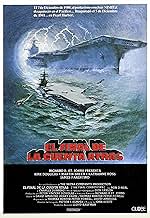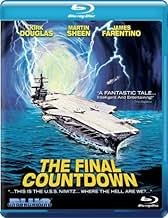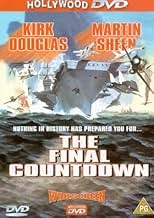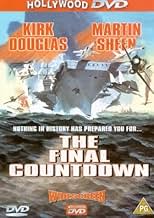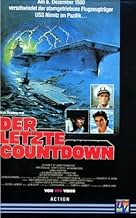Un porte-avions moderne est projeté dans le temps jusqu'en 1941 près d'Hawaï, quelques heures seulement avant l'attaque japonaise sur Pearl Harbor.Un porte-avions moderne est projeté dans le temps jusqu'en 1941 près d'Hawaï, quelques heures seulement avant l'attaque japonaise sur Pearl Harbor.Un porte-avions moderne est projeté dans le temps jusqu'en 1941 près d'Hawaï, quelques heures seulement avant l'attaque japonaise sur Pearl Harbor.
- Réalisation
- Scénario
- Casting principal
- Récompenses
- 1 victoire et 2 nominations au total
- Lt. Perry
- (as James C. Lawrence)
- Simura
- (as Soon-Teck Oh)
Avis à la une
To this day I wonder which, if any, sailors and Marines I saw were actual service people. If any were, Don Taylor and his second-unit directorial crew got excellent small performances from them. Here's an example: In a brief scene that probably barely survived the final cut, there's interaction among some sailors: "Christ, Chief, all we wanna know is what's going on," asserts one mildly exasperated rating. "If you need to know, you'll be told," replies the Chief Master-at-Arms curtly. The people who spoke this dialogue definitely weren't Screen Actors Guild types; they looked and sounded pretty much like sailors I've known. And that's a little detail that's done right so seldom that I hardly notice anymore that I'm deliberately overlooking it.
The aerial sequences set a standard that wouldn't be touched until /Top Gun/ hit the screen. To be sure, both movies relied to some extent on stock footage of naval-aviation ops, but as with /Top Gun/, this film's flying was spectacular -- and, in the last of the years before CGI took hold, REAL. (Compare this film's or /Top Gun/'s exteriors of aircraft with, say, /Air Force One/, and you'll see what I mean.
The "name-actor" ensemble of Kirk Douglas et al. performed, perhaps not brilliantly, but serviceably in a film that certainly was more plot-driven than character-focused. The story -- revealed by plenty of other comments here -- though implausible, is still capable of holding one's interest. But after you catch this flick on the tube for the second or third time, pay attention to the enlisted pukes doing their jobs -- to me, they're the real stars.
If it's on the shelf, rent it. If it's on TV again, watch it. At the least, it's an entertaining story. At its best, it's a good study in style and pacing.
Out of the blue, the vessel faces a weird storm and they find that they have traveled back in time to the eve of the attack of Pearl Harbor on 06 December 1941. When the two Japanese Zeros attack the motorboat of Senator Samuel Chapman (Charles Durning), the crew of the Nimitz rescues the senator and his assistant Laurel Scott (Katharine Ross). But sooner Lasky learns that the senator had disappeared on that day and Capt. Matthew Yelland is planning to attack the Japanese. Will these actions create a time paradox?
Today I have seen "The Final Countdown" maybe for the fifth or sixth time, and it is impressive how this good film has not aged after more than thirty years. The story has time paradox but is engaging supported by a magnificent cast. The DVD released on Brazil by New Line distributor is excellent, with audio Dolby 5.1 and DTS 6.1 and a documentary with the unit production manager Lloyd Kaufaman (Troma) in the Extras. My vote is seven.
Title (Brazil): "Nimitz - De Volta ao Inferno" ("Nimitz – Back to Hell")
Le saviez-vous
- AnecdotesA total of 48 real life U.S. Navy personnel from the USS Nimitz were credited in the closing credits for their performances as extras, background artists, or actors; some even had speaking parts.
- GaffesWhen Mr. Lasky first arrives on board the Nimitz, he is met at the hatch into the island by the XO, CDR Thurman. CDR Thurman has his cover on, on the flight deck, during flight operations. As the XO, he should know that covers are never worn on the flight deck during flight ops. The hat could get blown off his head and become FOD, or Foreign Object Debris, and possibly get sucked into a jet intake and cause major damage to the engine and maybe cost some sailors their lives.
- Citations
[an F-14 pilot is reporting the identity of a pair of enemy planes to Captain Yelland over the radio]
Captain Yelland: Alert 1 this is Eagle 1, what've you got?
Pilot: Two Japanese Zeroes, sir.
Captain Yelland: Two what?
Pilot: Two Trophy Class Mitsubishi A6Ms in original condition, complete with all markings. I mean, they look brand new sir!
Captain Yelland: Have you been spotted?
Pilot: Negative, we're right in the sun at their 6 o'clock high.
Captain Yelland: Stay in visual contact, take no action without clearance.
Pilot: Wilco Eagle 1, out.
- Versions alternativesUK cinema and video versions were cut by six secs to edit blood spurts from gunshots. In 2002 these cuts were waived by the BBFC.
- ConnexionsEdited from Tora ! Tora ! Tora ! (1970)
Meilleurs choix
- How long is The Final Countdown?Alimenté par Alexa
- What is the point of this film exactly?
- Had they stopped the airstrike would it have averted US involvement in WW2?
Détails
- Date de sortie
- Pays d’origine
- Langues
- Aussi connu sous le nom de
- El final de la cuenta atrás
- Lieux de tournage
- Sociétés de production
- Voir plus de crédits d'entreprise sur IMDbPro
Box-office
- Budget
- 12 000 000 $US (estimé)
- Montant brut aux États-Unis et au Canada
- 16 647 800 $US
- Montant brut mondial
- 16 647 800 $US
- Durée1 heure 43 minutes
- Couleur
- Mixage
- Rapport de forme
- 2.39 : 1
Contribuer à cette page






